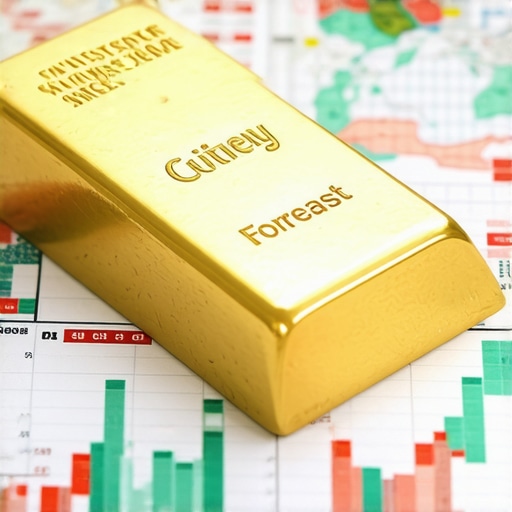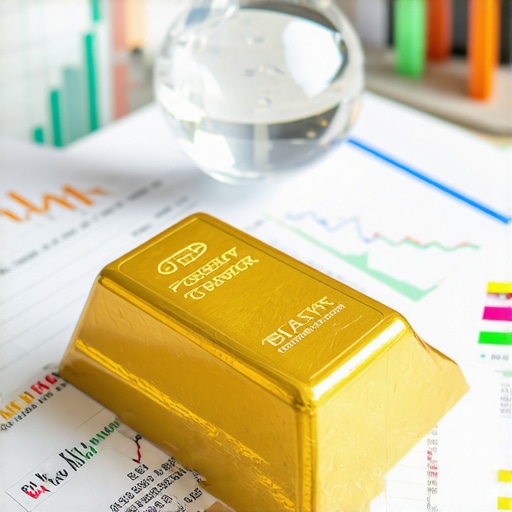The Next Chapter for Gold: A Deep Dive into 2025 Market Dynamics
As we approach the mid-2020s, understanding the trajectory of gold prices requires a nuanced analysis rooted in macroeconomic indicators, geopolitical shifts, and evolving investor behavior. Gold, long regarded as a safe haven asset, continues to be influenced by complex variables, including global economic stability, inflationary pressures, and central bank policies. This article synthesizes expert insights and market data to project plausible scenarios for gold’s valuation in 2025, offering valuable perspectives for seasoned investors and financial strategists.
Dissecting the Core Market Indicators Shaping Gold’s Future
How will inflation trends and monetary policies shape gold prices in 2025?
Inflation remains a critical driver, with many analysts emphasizing its role as an inflation hedge. Central banks’ responses—whether tightening or easing monetary policy—will significantly influence gold’s appeal. For instance, sustained inflationary pressures tend to boost gold demand, while aggressive rate hikes may temporarily suppress prices by strengthening the dollar. The interplay between real yields and inflation expectations will be pivotal in this context.
What role will geopolitical tensions and global economic stability play?
Persistent geopolitical uncertainties, including trade tensions and regional conflicts, amplify gold’s status as a safe haven. The potential for economic disruptions—highlighted by recent shifts in supply chains and international relations—could further elevate gold’s value. Moreover, emerging markets’ demand for physical gold, driven by economic growth and diversification efforts, will also influence price dynamics.
Forecasting Gold: Integrating Quantitative Models and Expert Opinions
Market forecasts in 2025 are increasingly reliant on sophisticated quantitative models that incorporate macroeconomic variables, sentiment analysis, and technical indicators. According to a recent market trend report, consensus points toward a moderate to bullish trajectory, with prices potentially reaching new highs if inflation persists and geopolitical risks escalate.
What are the best strategies to capitalize on expected volatility in gold prices?
Expert traders recommend deploying diversified strategies, including gold futures trading, options hedging, and allocation via gold ETFs. Understanding market timing, technical analysis, and macroeconomic signals is essential to navigate the anticipated volatility effectively. For a comprehensive approach, investors should also consider physical gold investments—such as coins and bars—as a long-term wealth preservation tool, especially in uncertain times.
For those seeking to diversify their portfolios, exploring top gold ETFs and mutual funds can offer liquidity and strategic exposure. Additionally, consulting authoritative sources like the World Gold Council provides insights into demand-supply dynamics and future market outlooks.
In conclusion, the future of gold prices in 2025 hinges on a confluence of macroeconomic stability, geopolitical developments, and investor sentiment. Staying informed through expert analyses and adapting strategies accordingly will be vital for maximizing returns and safeguarding wealth in the evolving landscape of global finance.
Innovative Investment Strategies for Gold in 2025: Beyond Traditional Approaches
As the global economy becomes increasingly complex, investors must adopt sophisticated strategies to capitalize on gold’s potential in 2025. While physical gold remains a cornerstone for wealth preservation, leveraging derivatives like gold futures and options can offer flexibility and enhanced risk management. According to a recent expert analysis, mastering technical signals and macroeconomic indicators is crucial for timing these trades effectively.
What cutting-edge tools can help investors predict and respond to gold market fluctuations?
Advanced analytics platforms now incorporate artificial intelligence and machine learning algorithms to analyze vast datasets, including geopolitical developments, currency trends, and inflation rates. These tools can generate real-time alerts and predictive models, empowering investors to make data-driven decisions. For example, integrating sentiment analysis from financial news and social media can reveal shifts in market perceptions, providing an edge over traditional analysis methods. Exploring such technologies is essential for those aiming to optimize their portfolios amid volatility.
Expanding Your Portfolio: Diversification with Gold-Related Assets
Beyond direct gold purchases, diversifying through gold-related assets such as mining stocks, ETFs, and mutual funds can enhance exposure while managing risk. Gold mining stocks, in particular, often outperform during periods of rising gold prices and can offer leverage due to operational efficiencies. A well-structured portfolio might include a mix of physical gold, ETFs, and mining equities, balancing liquidity, growth potential, and wealth preservation.
For insights on constructing such diversified portfolios, consulting sources like the top gold ETFs and mutual funds can provide strategic options tailored for 2025 market conditions.
How can investors leverage emerging economic trends and technological innovations to maximize gold-related returns?
Emerging trends such as the acceleration of digital currencies and blockchain technology are transforming the financial landscape. These innovations could influence gold’s role as a safe haven and diversify wealth storage solutions. For instance, gold-backed cryptocurrencies are gaining popularity, offering liquidity and ease of transfer, which appeals to tech-savvy investors. Monitoring these developments and understanding their implications can unlock new avenues for wealth growth and protection.
To stay ahead, investors should regularly review authoritative reports like those from the World Gold Council, which provides comprehensive analysis of demand-supply dynamics and future outlooks.
Are you interested in exploring how to integrate these advanced strategies into your investment plan? Sharing your thoughts and questions in the comments can foster a community of informed investors eager to adapt to the evolving gold market landscape.
Harnessing Technological Innovations and Market Synergies for Gold’s Future
As we delve deeper into the intricacies of gold investment in 2025, it’s crucial to recognize how cutting-edge technologies and market synergies are revolutionizing traditional perspectives. Artificial intelligence-driven predictive analytics, integrated with macroeconomic data, can now identify subtle shifts in demand-supply dynamics, geopolitical impacts, and investor sentiment. These tools not only enhance decision-making precision but also enable the anticipation of complex market reactions before they materialize, providing a strategic edge for sophisticated investors.
For example, machine learning algorithms that analyze news sentiment, social media trends, and financial indicators can forecast potential volatility spikes. This capability is invaluable in executing timely hedging strategies, such as options or futures, to protect against downside risks while capitalizing on upward movements. As highlighted by the World Gold Council’s latest market update, integrating such AI tools with traditional analysis forms a robust framework for navigating the unpredictable 2025 landscape.
Interplay Between Digital Assets and Gold: A New Frontier for Diversification
The evolution of digital assets, especially gold-backed cryptocurrencies and blockchain-based tokens, adds a compelling layer to portfolio diversification strategies. These digital assets combine the liquidity and transferability of cryptocurrencies with the intrinsic value and stability of gold, creating hybrid investment vehicles that appeal to the modern investor. Their emergence reflects a broader shift towards decentralized finance (DeFi) and digital wealth management.
Consider the potential of gold-backed stablecoins, which offer a hedge against fiat currency devaluation while maintaining operational flexibility. As these innovations gain traction, understanding their regulatory landscape, technological security, and market acceptance becomes paramount. Industry leaders like Tether Gold (Tether) exemplify this convergence, providing real-time price transparency and ease of access that traditional gold investments cannot match.
What are the critical considerations for integrating digital gold assets into traditional portfolios?
Investors must evaluate factors such as custody solutions, liquidity, regulatory compliance, and technological risks. Diversification across physical gold, ETFs, mining stocks, and digital assets can mitigate risks associated with each asset class, creating a resilient portfolio that adapts to evolving market conditions. Moreover, staying informed through authoritative sources like the World Gold Council helps in understanding the broader implications and future trajectories of these emerging assets.
Engaging with these innovations requires not only technical knowledge but also a strategic mindset that embraces change and complexity. By leveraging expert insights, advanced analytics, and technological tools, investors can craft sophisticated strategies that optimize returns while managing risks effectively in 2025 and beyond.
Are you ready to explore how digital assets and technological innovations can transform your gold investment approach? Share your questions and insights in the comments—let’s navigate this new frontier together.
Emerging Technologies Reshaping Gold Investment: The Role of Blockchain and AI
In the rapidly evolving landscape of financial assets, integrating blockchain technology and artificial intelligence (AI) into gold investment strategies has become more than a trend; it is a paradigm shift. Blockchain ensures transparency, security, and traceability for gold-backed digital assets, revolutionizing how investors perceive and utilize physical gold in a digital economy. Concurrently, AI-driven analytics provide predictive insights, enabling investors to anticipate market movements with unprecedented accuracy.
For instance, gold-backed cryptocurrencies such as Tether Gold exemplify this integration, offering liquidity and ease of transfer while maintaining the intrinsic value of gold. AI algorithms analyze macroeconomic indicators, geopolitical developments, and sentiment analysis from social media and news outlets, generating real-time alerts that facilitate proactive decision-making. As industry reports from the World Gold Council suggest, leveraging these technologies enhances portfolio resilience amidst volatility.
The Strategic Significance of Central Bank Policies and Digital Asset Adoption
Central banks worldwide are increasingly adopting digital assets and exploring CBDCs (Central Bank Digital Currencies), which could significantly influence gold’s role as a hedge. These policies may lead to increased demand for digital gold tokens and stablecoins, further integrating traditional assets with new financial instruments. The strategic consideration for investors lies in balancing exposure to physical gold, digital gold assets, and related derivatives to optimize risk-adjusted returns.
Moreover, the regulatory landscape is evolving, requiring meticulous due diligence. Entities like the market analysis reports emphasize the importance of compliance and security when investing in these emerging asset classes. Understanding jurisdictional differences and technological safeguards is essential for safeguarding investments.
How Can Investors Leverage Quantitative Models for Precision in Gold Market Timing?
Quantitative modeling, incorporating machine learning, sentiment analysis, and macroeconomic data, is transforming market timing strategies. Sophisticated algorithms can simulate various scenarios, identifying optimal entry and exit points based on volatility patterns, inflation expectations, and geopolitical risk factors. These models empower investors to navigate complex environments, minimizing downside risks while maximizing upside potential.
Institutions and savvy retail investors alike are urged to adopt platforms that integrate real-time data feeds and AI-driven forecasts. As detailed in the latest market forecasts, combining technical analysis with macroeconomic insights yields a strategic advantage in volatile markets.
Innovative Portfolio Diversification: Beyond Traditional Gold Assets
To truly harness gold’s potential in 2025, diversification across asset classes is paramount. This includes exposure to gold mining stocks, ETFs, derivatives, and digital gold tokens. Mining stocks, in particular, can outperform during bullish phases, providing leverage due to operational efficiencies. Diversification mitigates idiosyncratic risks and enhances the overall robustness of investment portfolios.
Consulting authoritative sources like the World Gold Council offers valuable insights into sector-specific trends, demand-supply dynamics, and innovative asset classes. Combining traditional and modern assets creates a resilient framework for wealth preservation and growth.
Are You Prepared for the Next Wave of Gold Investment Innovation?
Staying ahead in the gold market requires not only understanding emerging technologies but also embracing a strategic mindset that anticipates regulatory and geopolitical shifts. The integration of blockchain, AI, and digital assets offers unparalleled opportunities to optimize returns and manage risks. Engage with industry reports, technological tools, and expert consultations to craft a future-proof investment strategy.
To deepen your understanding and explore tailored solutions, consider connecting with financial advisors specialized in digital assets and precious metals. Your proactive engagement today can position you advantageously for the opportunities of tomorrow.
Expert Insights & Advanced Considerations
Innovative Strategies for Portfolio Diversification
Leveraging a mix of physical gold, ETFs, and mining stocks can optimize risk-adjusted returns, especially as geopolitical tensions and economic uncertainties persist. Diversification not only buffers against market volatility but also exploits different growth cycles within the gold sector.
Integration of Cutting-Edge Technologies
Utilizing AI-driven analytics and blockchain solutions enhances transparency and predictive accuracy. These tools enable investors to anticipate market shifts and execute timely trades, maximizing profit potential while safeguarding assets.
Monitoring Central Bank Policies and Digital Asset Adoption
Central banks’ increasing interest in digital currencies and gold-backed tokens influences supply-demand dynamics. Staying informed about regulatory developments and policy shifts is crucial for strategic positioning in 2025.
Advanced Market Timing with Quantitative Models
Implementing machine learning algorithms that analyze macroeconomic indicators, sentiment analysis, and technical signals provides a competitive edge. These models facilitate precise entry and exit points, reducing downside risks.
Emerging Digital Assets & Market Synergies
Digital gold assets, including cryptocurrencies backed by gold, are redefining liquidity and transferability. Incorporating these into portfolios offers new avenues for wealth preservation amidst evolving financial landscapes.
Curated Expert Resources
- World Gold Council: Provides comprehensive research, demand-supply analysis, and market outlooks essential for deep expertise.
- Financial Times & Bloomberg: Offer timely insights on macroeconomic trends, policy impacts, and market sentiment crucial for strategic planning.
- AI and Blockchain Innovation Reports: Industry publications detailing technological advancements transforming gold investment strategies.
Final Expert Perspective
Understanding the evolving landscape of gold investment in 2025 requires a sophisticated approach that harmonizes macroeconomic analysis, technological innovation, and strategic diversification. Embracing these advanced insights and leveraging authoritative resources will empower investors to navigate volatility and capitalize on emerging opportunities. Stay engaged, continuously educate yourself, and consider consulting with seasoned professionals to refine your investment strategies further.










